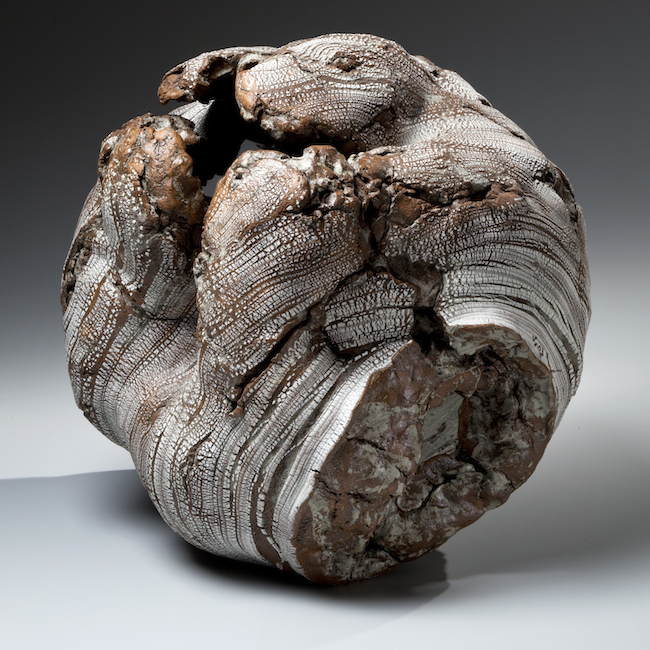NEW YORK — Joan B. Mirviss Ltd. is currently hosting two artists whose selections explore binaries in nature. Collapse/Rebirth (New York City, April 26 — May 27) collects sculptures by Japanese artists Fujino Sachiko and Futamura Yoshimi.
Above image: Futamura Yoshimi, Black Hole, 2015, 15 x 14 3/4 x 14 1/2 inches. Photographs by Richard Goodbody.
For this show the two artists have each created a body of work that, while aesthetically different, complement each other in theme. Fujino’s smooth, layered forms evoke the beauty of a flower about to blossom, while the rough, cracked surfaces of Futamura’s sculptures suggest the hidden, mysterious side of nature. This juxtaposition reminds us of a balance that can only be governed by the natural world— a cycle in which collapse kindles rebirth.

Futamura Yoshimi, Black Hole, 2015, 14 5/8 x 17 x 12 3/4 inches. Photograph by Richard Goodbody. Click to see a larger image.
Fujino Sachiko (b. 1950) has a certain elegance unmistakably derived from her background in design. She began her career in textiles as a fashion designer in Kyoto. After taking a pottery class in the early 1980s, however, she developed a passion for the clay medium, leading her to study under the pioneering female ceramist, Tsuboi Asuka. Since then, Fujino’s acclaim has only grown, as has her artistic style. Initially creating bold and powerful geometric forms, her most recent works have manifested into something more organic. For this exhibition, Fujino recalls childhood memories of a garden where flowers in full bloom competed with disorderly weeds. The artist believes:
“We see in nature an infinite number of relations that exist in delicate balance. There is a similarity between this balance with nature and the equilibrium necessary to create sculptural works. When I start my coil building process, the form is ever expanding and reveals itself to me through my manipulation of the clay.”

Fujino Sachiko, Interconnection 15-1, 2015, 18 1/2 x 9 5/8 x 6 1/4 inches. Photograph by Nagata Yō. Click to seea larger image.
Without using maquettes and without the finished form in mind, Fujino relinquishes control to her coil-building technique. The struggle with her medium continues until the very end when Fujino finally discovers the completed sculpture. She uses an airbrush to dust her otherwise unadorned works with matte slip and sometimes adds a touch of colored glaze. The finished work seems to be on the brink of unfolding into full bloom just like the flowers from her childhood, revealing hidden layers of clay and life.
Nagoya-native Futamura Yoshimi (b. 1959) was traditionally trained at the Seto School of Ceramics in 1979 where she first embraced the techniques of the historic Seto ceramic center, one of the Six Old Kilns. After moving to France seven years later, her work has truly matured with an elegant, Parisian flair. Using a blend of stoneware clays and a mixture of fired and raw granulated porcelain, she creates the textured, geological forms for which she is best known. Through this innovative process, Futamura reveals the power inherent within her medium. The deep cavities in her work that accompany fissured surfaces seem on the brink of bursting into expansion or sinking into collapse.
Despite her move to Paris, Japan unquestionably remains deeply rooted in the heart of her artwork. This exhibition is part of Futamura’s continued response to the tragic Tōhoku earthquake and tsunami of March 11, 2011, that took place while she was preparing for a solo exhibition at Musée Ariana in Geneva, Switzerland. This disaster profoundly shook Futamura, who suddenly realized that even her tranquil birthplace was vulnerable to the whims of nature. As Futamura states:
“My work represents a fear for the uncertain, a force beyond our control which threatens to extinguish everything, even the desire for rebirth. The Tōhoku earthquake reminded me of how grateful I am to have grown up in Japan, as I could not be where I am today without its cultural influence. It is my hope that this exhibition introduces art to America that embodies a Japanese foundation with a Parisian essence.”

Fujino Sachiko, Transformation 14-4, 2014, 12 1/8 x 23 5/8 x 20 inches. Photograph by Nagata Yō. Click to see a larger image.
Fujino’s work has been highly awarded both nationally and internationally. Not only was her work represented in the renowned traveling exhibition, “Soaring Voices: Contemporary Japanese Women Ceramic Artists” from 2007 to 2012, but museums such as the Faenza International Ceramic Museum, Italy; Kyoto City Cultural Museum; Minneapolis Institute of Art, MN; Museum of Fine Arts, Boston, MA; Samuel P. Harn Museum of Art, FL; and Yale University Art Gallery, CT to name a few, hold her artwork in their permanent collection.
Futamura has received numerous honors for her work. Most recently, she has been included in the current CERAMIX Cité de la Céramique-Sèvres-Maison Rouge-Paris, France that traveled from the Netherlands this year. Museums with works in their permanent collection include the Brooklyn Museum, NY; Lowe Art Museum, FL; Musée de Céramique d’Andenne, Belgium; Musée Français de Céramique de Fuping, China; New Orleans Museum of Art, LA; Samuel P. Harn Museum of Art, FL; Yale University Art Gallery, CT and more.
Text (edited) and images courtesy of the gallery.
Do you love or loathe these works of contemporary ceramic art? Let us know in the comments.

Great work! I love Futamura Yoshimi’s creations. I have never before seen anything like it and it is totally organic which has always been my favorite. Juxtaposed are the clean architectural forms of Fujino Sachiko, and then an organic shape as well. Totally cool! I wished I could see them in person! I am sure they will sell quickly!
These are stunning pieces. I love the more contemporary work. Thank you for showing it.